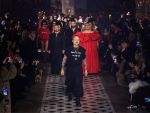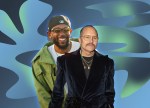Willy Chavarria is shaping the future of fashion, the Chicano way.
Born and raised in Fresno, California, his parents interracial relationship in the 1950s made Chavarria abundantly aware of his migrant roots, being working class, and the prejudices against someone like him, a queer brown man. Like most Latine people in the U.S., he had two choices when it came to being in a place that makes us feel othered: you either assimilate or you embrace who you are and run with it. Willy Chavarria embraced who he was and ran with it.
Now 58-years-young, Chavarria is the founder and CCO of his fashion label of the same name. His brand is a fusion of streetwear and high fashion. But it’s also keenly aware of the sociopolitical commentary going on in the world while uplifting Chavarria’s Chicano heritage and identity. When it comes to his clothes he plays around with subversive details that blend in oversized Chicano aesthetics with queer and religious iconography. And just this year, Chavarria got to bring all of that to Paris for his first ever show at Paris Fashion Week.

Remezcla got a chance to interview Chavarria at Parsons School of Design in New York City about that milestone in Paris. But we also talked about the importance of honoring your identity and building up the next generation of designers. Because as much as he’s making people feel seen through his fashion, gender fluid aesthetics, and political commentary, he’s also inspiring them. And our job as creatives is to break barriers, elevate, and empower those who follow after us.

“The Paris show was so important to me because I did want to have a lot of Latino talent visible for everyone to see, so that we could see all of our strengths together,” Chavarria said about the Paris debut. “And it was fun working with them, but crazy of course. […] But just seeing like Becky G, J Balvin, and everyone there, it was just so cool, so powerful and beautiful.” Other Latine talent such as Tokischa, Indya Moore, Paloma Elsesser, Ozuna, Danny Ramirez and more walked Chavarria’s Tarantula show at the American Church in Paris.
Putting Latine people center stage on a platform like Paris Fashion Week, is in itself a political statement because people like us don’t usually end up at Paris Fashion Week. And here Chavarria is going, “Yes, we can.” and “Yes, we will.” When asked about the driving force behind incorporating his Latine identity into his work, the answer was simple: it’s about our voices. “It’s very important for me to incorporate the voices of people, anyone who’s related to me and my own culture. So I incorporate that into all of my work to provide a loud, positive voice so that we can all be seen in a beautiful light.”
Being Chicano isn’t the only part of his identity that Chavarria explores through this brand. He’s also openly queer, something he constantly brings into his collections or collaborations, like the work he recently did with Latino Fan Club. And during his Tarantula show in particular, he proudly brought his queer identity to Paris Fashion week through the models clothes. But he also did it by wearing a shirt that says, “How we love is who we are.” The shirt was visible as he led all the models and they played Bishop Mariann Edgar Budde’s sermon in the background where she called for “compassion” for the LGBTQ+ community from President Donald Trump.

For Chavarria, wearing the shirt was as much about pushing fashion forward as much as it was a reminder that love is love. “How we love is who we are, and that is a shirt I did as part of a campaign with the Human Rights Campaign to remind us about how important it is to be loving and to show love for all our brothers and sisters.”

Every collection and every moment has led to this point where people are inspired by him.
At the Parsons School of Design, Chavarria sat down to speak with Julie Gilhart about pushing fashion forward. And at the end of the conversation they opened the floor for conversations. Student after student asked for his perspective on navigating the fashion industry. But a lot of people like Willy Chavarria himself, Latine people, took a moment to thank him for what he’s done, how he continues to bring us into these rooms, and how he makes Latine people feel seen.

When it comes to this position he’s in, to help the next generation of designers and creatives, Chavarria is honored. He said, “It is very important to me, and it’s also very flattering that I am in a position where I can actually maybe impart some knowledge to people who are younger than me.” It’s also important to Chavarria to think about who comes after him, because someone inspired him when he was young. He said, “I remember when I was young, I went and saw Willi Smith, who was the designer for WilliWear back in the 80s. And I just heard him talking to somebody else, talking to Perry Ellis, actually, at the time. And it stayed with me for so long that even up until now, I remember that conversation, and I’m just so happy that I can actually do the same now for other people.”
One day, those students at Parsons School of Design will hopefully end up in an auditorium just like the one Chavarria was in. And when that designer, be they Latine or not, gets asked who inspired them when it comes to their work, they’ll stop and say, “I remember when I was young, I went and saw Willy Chavarria back in 2025. And I heard him talking. And it stayed with me for so long that even up until now, I remember how he inspired me.”





